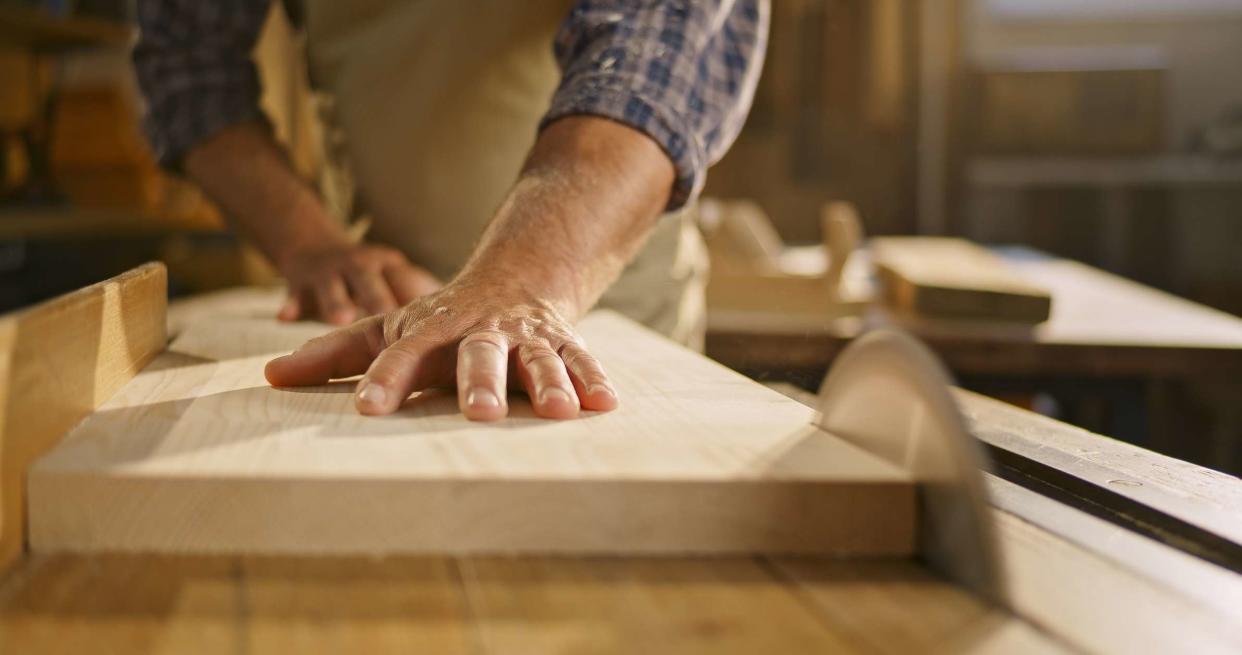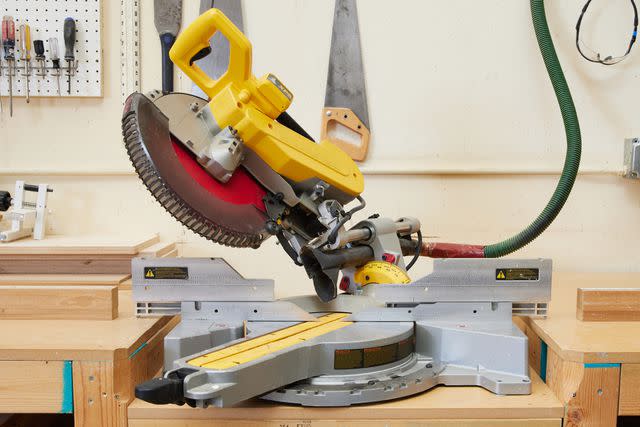Miter Saw vs. Table Saw: Is There Really a Difference?

simonkr / Getty Images
Miter saws have a small base positioned under the saw blade, which sits above on a moveable arm. The material sits on the base, then the DIYer brings the rotating blade down to cut cleanly through the material. A table saw has a large table-sized base and a cutting blade which protrudes up from the middle of the table. Users move the material through the blade, instead of moving the blade through the material.
Find out more about the differences between a miter saw versus a table saw with this informative guide.
Miter Saw vs. Table Saw: Major Differences

The Spruce / Jacob Fox
Miter sawMiter saws can make accurate, repeatable crosscuts, beveled cuts, and angled or miter cuts, while table saws can be used for a wider variety of cuts, including rip cuts, crosscuts, bevel cuts, and angle cuts. For miter saws, you can set the position of the saw blade, then simply lower the blade down into the material. Table saws are not as precise, since the accuracy relies on the person to move the material through the saw blade.
Generally, a table saw is best for larger pieces of material, like sheets of plywood or long planks, while a miter saw is better for cutting through small pieces of wood, like baseboard trim. However, miter saws can be packed up into a vehicle with relative ease, making them better for portability. Additionally, miter saws tend to cost less and are typically less intimidating to work with for new or inexperienced DIYers.
Miter Saw
Better for smaller pieces of wood and other material
Makes precise, repeatable cuts with high accuracy
Not a good choice for making rip cuts through large material
Excellent for making accurate crosscuts
Designed for making repeatable angled and beveled cuts
Good for portability
Moderately versatile
Average cost of $300 to $1,000
Table Saw
Well suited for large sheets of wood and other material
Makes moderately accurate cuts through material
Frequently used to make long, accurate rip cuts
Can make moderately accurate crosscuts
Can be used for angled or beveled cuts with the right accessories
Generally fixed in place
Highly versatile
Average cost of $200 to $5,000
Miter Saw vs. Table Saw: Material Size

The Spruce / Jacob Fox
Table sawMiter saws are ideal for small, thin materials that can fit on the narrow base. Generally, these saws have blades that range from eight to 12 inches in width, though some saws may have a sliding arm to increase the cutting length. Table saws can be used for small materials, but they really excel when used with long planks or large sheets of wood. The material can be fed into the stationary saw for both crosscuts or rip cuts.
Miter Saw vs. Table Saw: Accuracy
The exact level of accuracy required for a project varies depending on the job. For instance, accuracy is more important when cutting corner trim that needs to fit together at a precise angle, than it is when cutting deck or fence boards to the proper length. In most cases, a miter saw is considered more accurate than a table saw, allowing this tool to be used for more precise woodworking jobs.
Another factor that improves miter saw accuracy is that there is less room for user error. After setting the blade and placing the material on the base, all the DIYer needs to do is bring the rotating blade down and through the material. However, when using a table saw, the user is responsible for moving the material through the saw blade, which can affect the accuracy. Though, table saw accuracy can be improved with the use of guide or jig.
Miter Saw vs. Table Saw: Rip Cuts
Rip cuts refer to cuts made along the length of the wood, as opposed to crosscuts, which are made across the width of the wood. Miter saws are not a good choice for rip cuts. The blade is not positioned in the right orientation to make rip cuts along the selected material. Instead, go with a table saw, which is one of the best option for long, accurate rip cuts along the length of planks or through sheets of plywood. Just make sure to use the rip fence to help keep the cut straight.
Miter Saw vs. Table Saw: Crosscuts
A crosscut refers to cuts that are made across the width of the material. These cuts are incredibly common during DIY woodworking jobs, since most planks or lengths of wood will need to be cut or have a few inches trimmed off to create pieces that are the right size for the project. Due to the orientation of the base and the position of the blade, miter saws are better for crosscuts than table saws.
Miter saws can make accurate and repeatable crosscuts quickly and effectively. A table saw can also be used to make crosscuts, though the accuracy is heavily dependent on the user, so they are better for one-time cuts, instead of making repeat cuts. Improve the accuracy and stability of table saw crosscuts with a crosscut sled or jig.
Miter Saw vs. Table Saw: Angled and Bevel Cuts
Angled cuts can also be called miter cuts. This refers to cuts made at less than or greater than 90 degrees, while bevel cuts are made by tilting the saw blade laterally to create a sloped or beveled edge, instead of a flat edge. Miter saws, as the name implies, are designed for the purpose of making accurate angled or miter cuts, so it should come as not surprise that a miter saw is better than a table saw for cutting precise angles.
Compound miter saws can even make both angled and bevel cuts at the same time by adjusting the position of the blade. Table saws can make both angled and bevel cuts with moderate accuracy, though cutting bevels on a table saw is a challenge that is best left to advanced woodworkers.
Miter Saw vs. Table Saw: Portability
The arm on a miter saw can be locked in place and the entire 30- to 40-pound saw can be loaded into the back of a truck or car for easy transportation. However, a table saw is significantly less portable due to the sheer size and weight, which can exceed 200 pounds. While some table saws feature wheeled stands, they are still generally considered less portable than a miter saw.
Miter Saw vs. Table Saw: Versatility
Miter saws are relatively versatile, allowing DIYers to make crosscuts, angled cuts, and bevel cuts with a high degree of accuracy. However, table saws tend to be more versatile, since they can be used for a wider variety of cuts, like rip cuts, crosscuts, bevel cuts, angled, cuts, and more. The versatility of a table saw can also be increased with the use of specific accessories, like guides or jigs.
Miter Saw vs. Table Saw: Cost
Generally, a miter saw is less expensive, making it a good choice for new or inexperienced DIYers. Expect to pay about $300 to $1,000 on average for a quality miter saw. Table saws are more of an investment, ranging in price from about $200 to over $5,000.
Frequently Asked Questions
What is better, a miter saw or a table saw?
Neither a miter saw or a table saw are definitively better than the other because they are both used for different types of cuts. Miter saws can make accurate, repeatable crosscuts and angled cuts, while table saws excel in making long, lengthwise rip cuts.
Can you use a miter saw as a table saw?
Given the operational difference between these saws, it isn't a good idea to try to use a miter saw as a table saw. A miter saw has a mounted blade that comes down from above to cut through the wood, while the blade of a table saw sits in a fixed position in the base of the table, allowing the user to move the material through the blade.
Can you cut a 2x4 with a miter saw?
A miter saw can absolutely be used to cut through a 2x4, though the exact size of the saw blade can impact the effectiveness of the tool. Larger blades are able to handle larger pieces of material, allowing the miter saw to make crosscuts or angled cuts without a problem. It's worth noting that a table saw is effective for both cross and rip cuts through 2x4s, so if you have to choose, a table saw is typically the better choice for cutting larger materials.
Read the original article on The Spruce.

